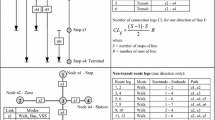Abstract
This paper aims to integrate mode, line, and frequency for a new transit line. The model has a bi-level structure in which the upper level of the model is formulated to determine mode selection, line configuration, and frequency, whereas the lower level of the model is formulated to determine mode share and link flows in order to reflect travelers’ behaviors related to choices of modes and routes. An application of the proposed model uses a test network. The results of this application show that the proposed model performs better than the existing methods. The model realistically simulates the influence of a new transit line on its surrounding network by reflecting changes in travelers’ behaviors according to the transit line’s construction, and it also provides a theoretical basis for the evaluation of the feasibility of the planned investment in a new transit system.
Similar content being viewed by others
References
Beckmann, M., McGuire, C. B., and Winsten, C. B. (1956). Studies in the economics of transportation, Yale University Press, New Haven, Conneticut.
Ben-Akiva, M. and Lerman, S. R. (1987). Discrete choice analysis: theory and application to travel demand, MIT Press, Cambridge.
Ceder, A. (2003). Advanced modeling for transit operations and service planning, Pergamon Imprint, New York.
Ceder, A. and Wilson, N. H. M. (1986). “Bus network design.” Transportation Research Part B: Methodological, Vol. 20, No. 4, pp. 331–344.
Daganzo, C. F. (1997). Fundamentals of transportation and traffic operations, Elsevier Science, New York.
Fan, W. and Machemehl, R. B. (2004). Optimal transit route network design problem: Algorithms, implementations, and numerical results, Publication SWUTC-04-167244-1. U.S. Department of Transportation.
Guan, J. F., Yang, H., and Wirashinghe, S. C. (2006). “Simultaneous optimization of transit line configuration and passenger line assignment.” Transportation Research Part B: Methodological, Vol. 40, No. 10, pp. 885–902.
Guihaire, V. and Hao, J. K. (2008). “Transit network design and scheduling: A global review.” Transportation Research Part A: Policy and Practice, Vol. 42, No. 10, pp. 1251–1273.
Hubbell, J., Wirasinghe, S. C., McKendrick, N., Morgan, D., Wong, F., and Thilakaratne, R. (2009). “Mode succession in a public transit corridor.” Urban Transport XV-Urban Transport and the Envionment, pp. 23–34.
Kepaptsoglou, K. and Karlaftis, M. (2009). “Transit route network design problem: Review.” Journal of Transportation Engineering, Vol. 135, No. 8, pp. 491–505.
Kim, H. (2007). Developing guidelines for evaluating and selecting urban rail transit systems, The Korea Transport Institute, Goyang, Republic of Korea.
Korea Development Institute (KDI). (2008). Standard guidelines for the preliminary feasibility study of roads and railroad construction projects, 5th ed. Republic of Korea Ministary of Stretage and Finance.
Lamplkin, W. and Saalmans, P. D. (1967). “The design of routes, service frequencies and schedules for a municipal bus undertaking: A case study.” Operation Research Quarterly, Vol. 18, No. 4, pp. 375–397.
Lee, Y. J. and Vuchic, V. R. (2005). “Transit network design with variable demand.” Journal of Transportation Engineering, Vol. 131, No. 1, pp. 1–10.
Mandl, C. (1979). Applied network optimization, Academic Press, London.
Parajuli, P. M. and Wirasinghe, S. C. (2001). “A line haul transit technology selection model.” Transportation Planning and Technology, Vol. 24, No. 4, pp. 271–308.
Rea, J. C. (1972). “Designing urban transit systems: An approach to the route-technology selection problem.” Highway Research Board, No. 417, pp. 48–59.
Sheffi, Y. (1985). Urban transportation networks: Equilibrium analysis with mathematical programming methods, Prentice-Hall, Englewood Cliffs, New Jersey.
Van Nes, R. and Bovy, P. (2000). “Importance of objectives in urban transit-network design.” Transportation Research Record, No. 1735, pp. 25–34.
Vuchic, V. R. (2005). Urban transit: Operations, planning, and economics, John Wiley & Sons, Hoboken, New Jersey.
Vuchic, V. R. (2007). Urban transit: Systems and technology, 2nd ed. John Wiley & Sons, Hoboken, New Jersey.
Yang, M., Wang, W., Chen, X. W., and Li, W. Y. (2006). “Decisionmaking method for mass rapid transit mode selection based on DEA/AHP.” Journal of Highway and Transportation Research and Development, Vol. 23, No. 7, pp. 111–115.
Zhao, F. and Ubaka, I. (2004). “Transit network optimization-minimizing transfers and optimizing route directness.” Journal of Public Transportation, Vol. 7, No. 1, pp. 67–82.
Author information
Authors and Affiliations
Corresponding author
Rights and permissions
About this article
Cite this article
Kim, HS., Kim, DK., Kho, SY. et al. Integrated decision model of mode, line, and frequency for a new transit line to improve the performance of the transportation network. KSCE J Civ Eng 20, 393–400 (2016). https://doi.org/10.1007/s12205-015-0575-x
Received:
Revised:
Accepted:
Published:
Issue Date:
DOI: https://doi.org/10.1007/s12205-015-0575-x




